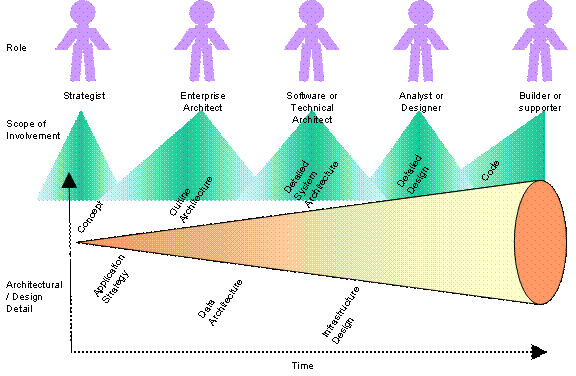The Changing Role of An IT Architect
An IT architect (for want of a generic term which isn't already terribly overloaded) takes on many different roles over time.
On a single project, the focus will change as the system's architectural detail matures. The same person may undertake different roles, changing his or her focus, or different people may take on different architectural roles. The latter is typical if there's a large architectural team, or responsibilities are split between architectural, development and technology support groups.
For a portfolio of projects, the focus may be different for different projects at the same time, simply because each project is at a different point in the life cycle. Again, a single person can change focus and role, or different people fill the different roles.
Finally, people change over time. As a person's interests and skills develop, he or she may feel happier concentrating on different parts of a system's life-cycle. If an architect has particular skill explaining concepts to business people, he will naturally focus at the strategic end. Another with deep technical skills will focus at greater levels of detail.
The diagram shows how all the "architectural" roles relate to a typical system:

In fact, the picture is even more complicated, because as the system matures a team of people become involved, each with a different role and focus. so at the right-hand end of the picture we should show several overlapping roles. The total breadth of architectural knowledge increases so no one person can hold it all, and architectural responsibility is typically split, at least between hardware, software and data.
Each architect has a different "range of vision", and that may change depending on his role within the project. The "gaps" between the different ranges of vision may also be important, because these represent potential areas for failure in communication, where one person cannot "get down to the level" of another and vice-versa.
Finally, it's not right to talk about "a progession", "seniority" or natural reporting hierarchy between different architecture roles. These things do exist, but they are independent of the varying roles that architects naturally have.
 Thoughts on the World (Main Feed)
Thoughts on the World (Main Feed) Main feed (direct XML)
Main feed (direct XML)